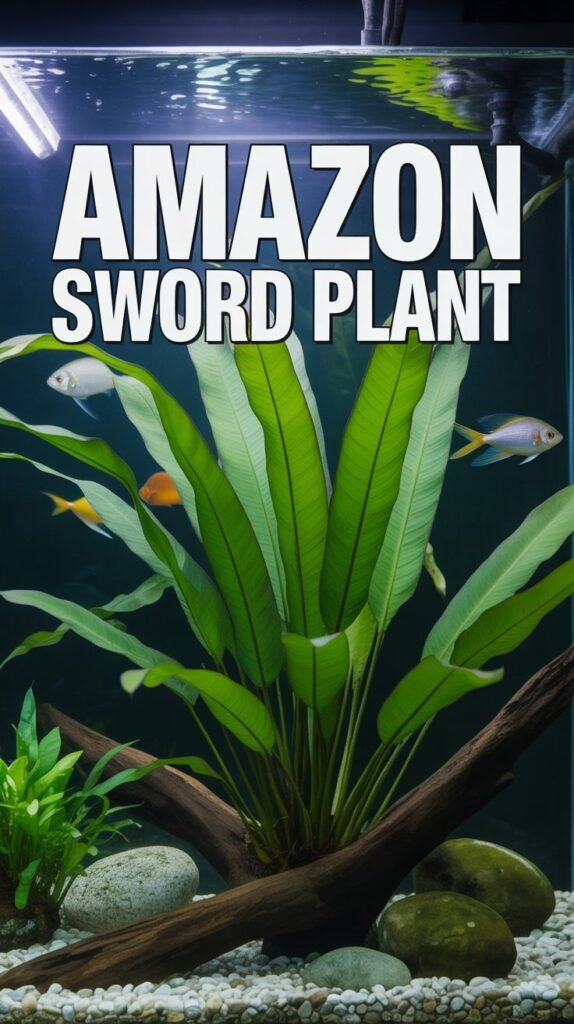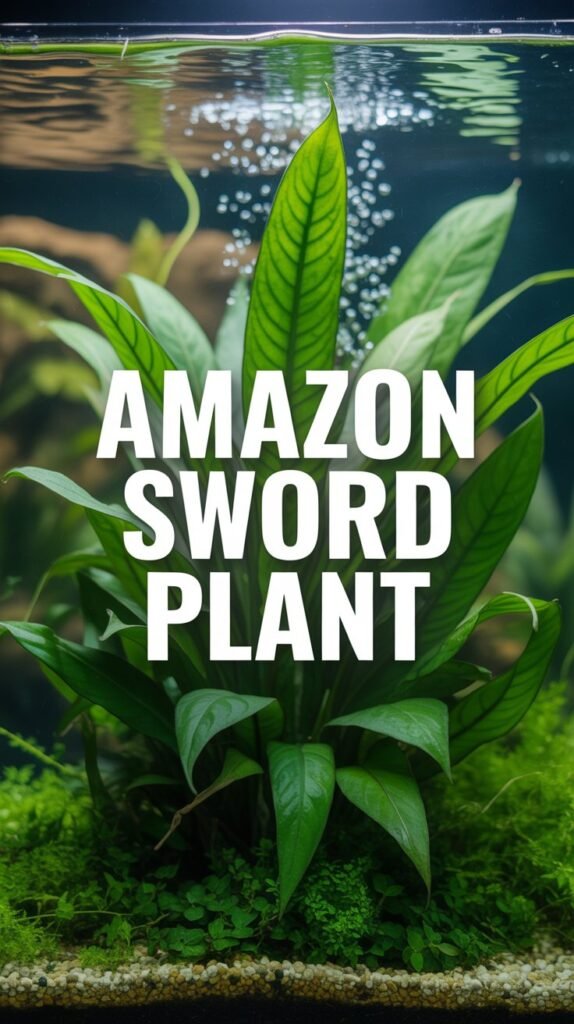The Amazon Sword Plant (Echinodorus grisebachii or Echinodorus amazonicus) is one of the most popular aquatic plants among aquarium enthusiasts worldwide. Known for its broad, sword-shaped leaves and lush green appearance, this plant is a stunning centerpiece for freshwater aquariums. It’s hardy, adaptable, and suitable for both beginners and seasoned aquarists.
Native to the Amazon River Basin in South America, this aquatic plant thrives in tropical freshwater environments and plays a vital role in maintaining water quality. Beyond aesthetics, the Amazon Sword Plant provides shelter for fish, helps oxygenate the water, and supports a balanced ecosystem.
In this guide, we’ll explore everything you need to know about the Amazon Sword Plant, including its origin, care requirements, propagation, common problems, and practical tips to help it thrive in your aquarium.
Origin and Natural Habitat
The Amazon Sword Plant originates from the Amazon River Basin, stretching across countries like Brazil, Peru, and Colombia. In its natural habitat, the plant grows partially or fully submerged in slow-moving rivers, streams, and flooded forest areas.
The Amazon’s tropical climate—warm water temperatures, high humidity, and nutrient-rich substrates—creates the perfect environment for this plant to flourish. Its large leaves allow it to absorb sunlight efficiently, even in dimly lit waters.

When cultivated in aquariums, replicating these natural conditions is key to promoting healthy growth.
Physical Appearance and Characteristics
The Amazon Sword Plant is easily recognized by its broad, elongated, and pointed leaves, resembling a sword. This unique appearance is what gives the plant its name.
Key Features:
- Leaf Shape: Long, lanceolate, and pointed tips.
- Color: Vibrant green, sometimes with slight reddish hues under high light.
- Size: Typically grows 12–20 inches tall, though in optimal conditions, it can reach over 24 inches.
- Root System: Strong and extensive, helping anchor the plant securely in the substrate.
- Growth Pattern: Grows from a central rhizome, producing new leaves in a rosette form.
Due to its size, the Amazon Sword is ideal as a background or centerpiece plant in medium to large aquariums.
Ideal Tank Conditions
To keep your Amazon Sword Plant healthy, it’s essential to provide the right tank environment. While this species is known for being hardy, optimal conditions ensure vibrant growth and longer lifespan.
1. Tank Size
The Amazon Sword Plant can grow quite large, so it’s best suited for tanks of at least 20 gallons (75 liters) or larger. Smaller tanks can restrict root development and cause the plant to outgrow the space quickly.
2. Lighting Requirements
Moderate to high lighting is ideal. The Amazon Sword thrives under 2 to 3 watts per gallon of full-spectrum aquarium light. Insufficient lighting can lead to pale leaves and slower growth, while too much light can promote algae growth.
3. Water Parameters
- Temperature: 72°F – 82°F (22°C – 28°C)
- pH: 6.5 – 7.5 (slightly acidic to neutral)
- Hardness: 3 – 8 dKH
- Water Flow: Gentle to moderate
4. Substrate
The Amazon Sword Plant is a heavy root feeder, meaning it draws most of its nutrients from the substrate rather than the water column. Use a nutrient-rich substrate such as aquarium soil or fine gravel mixed with root tabs. Avoid coarse gravel, as it can damage the roots.
5. Fertilization and CO₂
While the Amazon Sword can grow without CO₂ injection, adding CO₂ supplementation and liquid fertilizers significantly boosts growth and color intensity. Root tabs placed near the roots every few weeks help supply essential nutrients like iron and potassium.
Planting and Placement
Proper planting ensures the Amazon Sword establishes strong roots and grows effectively.
Steps for Planting:
- Choose the Right Spot: Since it can grow tall, plant it in the background or center of the aquarium.
- Prepare the Substrate: Ensure at least 2–3 inches of nutrient-rich substrate.
- Planting Depth: Bury the roots firmly in the substrate, but keep the crown (where leaves emerge) above the substrate to prevent rot.
- Spacing: Leave enough space between other plants to avoid overcrowding and allow light penetration.
Once planted, the Amazon Sword may take a few weeks to acclimate, during which some older leaves might melt or turn yellow. This is normal and part of the plant’s adjustment process.
Maintenance and Care
The Amazon Sword Plant is relatively low-maintenance but requires consistent care to maintain its lush appearance.
1. Trimming and Pruning
Regular pruning helps manage its size and encourages new growth. Remove yellow, damaged, or algae-covered leaves using clean scissors. Avoid cutting too close to the crown, as this can harm the plant.
2. Nutrient Management
Since it’s a root feeder, using root tabs every 4–6 weeks ensures the plant receives adequate nutrients. Supplement with liquid fertilizers containing iron for greener, healthier leaves.
3. Lighting Management
Avoid excessive light exposure, as it can lead to algae growth on the leaves. Maintain a consistent 8–10 hours of light daily with a timer.
4. Water Changes
Perform regular water changes (25–30% weekly) to remove excess waste and maintain stable water chemistry. Clean water helps prevent nutrient imbalances and promotes healthy growth.
5. CO₂ Injection
Although optional, CO₂ supplementation enhances growth speed and leaf size, especially in heavily planted tanks.
Propagation of Amazon Sword Plant

Propagating the Amazon Sword is straightforward, making it a favorite for hobbyists who want to expand their plant collection.
1. Runners and Plantlets
The most common propagation method is through runners. Mature Amazon Swords produce long stems that develop small plantlets or “baby plants.”
Steps:
- Wait until plantlets develop several leaves and small roots.
- Carefully cut the runner connecting the baby to the mother plant.
- Plant the new plantlet in the substrate.
Within a few weeks, the baby Amazon Sword will establish its roots and grow independently.
2. Division
For large, mature plants, you can also divide the root crown into two or more sections and replant each separately. However, this method is riskier and should only be done on healthy plants.
Tank Mates for Amazon Sword Plant
The Amazon Sword Plant is peaceful and compatible with a wide variety of freshwater fish and plants. It provides natural shelter, especially for shy or small fish.
Ideal Tank Mates:
- Guppies
- Tetras (Neon, Cardinal, Rummy Nose)
- Angelfish
- Discus
- Corydoras Catfish
- Mollies
- Platies
- Swordtails
Avoid:
- Goldfish: They tend to uproot and nibble on plants.
- Large Cichlids: Such as Oscars, which may dig up or damage leaves.
Shrimp and snails like Amano Shrimp and Nerite Snails also pair well, helping keep algae under control.
Common Problems and Solutions
Even though Amazon Swords are hardy, they can experience a few common issues. Here’s how to identify and fix them.
1. Yellowing Leaves
Cause: Nutrient deficiency, particularly iron.
Solution: Add iron-rich fertilizers or root tabs.
2. Melting Leaves After Planting
Cause: Transition stress from emersed (grown above water) to submerged growth.
Solution: Remove melted leaves and allow time for new submerged growth to emerge.
3. Algae Growth
Cause: Too much light or excess nutrients.
Solution: Reduce light duration, introduce algae-eating fish, and maintain regular water changes.
4. Slow Growth
Cause: Low light or nutrient deficiency.
Solution: Increase lighting intensity and use balanced fertilizers.
5. Root Rot
Cause: Crown buried too deep or poor water circulation.
Solution: Replant ensuring the crown is above the substrate.
Benefits of Amazon Sword Plant
The Amazon Sword Plant offers several advantages beyond aesthetics:
- Natural Beauty: Adds lush greenery and depth to any aquarium.
- Improves Water Quality: Absorbs excess nitrates and phosphates, reducing toxins.
- Oxygenation: Enhances oxygen levels in the water.
- Shelter and Breeding Ground: Provides hiding spots for fry and shy fish.
- Low Maintenance: Suitable for beginners due to its hardy nature.
- Versatile Placement: Works well as a background or centerpiece plant.
Tips for Healthy Growth
- Use nutrient-rich substrate: Essential for strong root development.
- Maintain stable lighting: 8–10 hours daily is ideal.
- Fertilize regularly: Root tabs and liquid fertilizers keep the plant lush.
- Avoid overcrowding: Give ample space for leaf expansion.
- Monitor water parameters: Stable pH and temperature promote consistent growth.
- Prune regularly: Encourages new leaves and prevents algae buildup.
Varieties of Amazon Sword Plant
There are several popular varieties of the Amazon Sword, each with slight differences in size, shape, or color:
- Echinodorus amazonicus – The classic, most common type.
- Echinodorus bleheri – Larger leaves, often more robust; ideal for big tanks.
- Echinodorus parviflorus – Compact variety suitable for smaller tanks.
- Echinodorus ozelot – Features reddish spots on the leaves, adding visual appeal.
- Echinodorus cordifolius – Heart-shaped leaves and taller growth.
Choosing the right variety depends on your tank size, lighting, and aesthetic preferences.
Troubleshooting and Reviving a Dying Amazon Sword

If your Amazon Sword looks unhealthy, don’t worry—most issues are reversible.
Step-by-Step Revival Tips:
- Check Lighting: Ensure proper light intensity and duration.
- Test Water Quality: Verify temperature, pH, and hardness are within optimal range.
- Examine Roots: If roots are rotting, trim damaged parts and replant.
- Fertilize Appropriately: Add root tabs for nutrient support.
- Trim Dead Leaves: Removing decaying foliage helps the plant focus energy on new growth.
- Avoid Sudden Changes: Keep environmental conditions stable.
With patience and consistent care, most Amazon Sword Plants bounce back beautifully.
Creating an Aquascape with Amazon Sword Plant
The Amazon Sword is a favorite in aquascaping due to its majestic size and lush green color. It works wonderfully as a focal point plant.
Design Ideas:
- Amazon Biotope Setup: Combine with driftwood, sand substrate, and small schooling fish like tetras for a natural Amazon look.
- Community Tank: Pair with carpeting plants (like dwarf hairgrass) and midground species (like Cryptocoryne).
- Planted Jungle Style: Combine multiple Amazon Swords in large tanks for a dense, forest-like effect.
When designing your aquascape, consider varying plant heights, colors, and textures to create a balanced underwater landscape.
Conclusion
The Amazon Sword Plant is a true gem for freshwater aquariums. Its elegance, resilience, and ecological benefits make it a must-have for aquarists of all levels. Whether you’re building a natural biotope or a lush aquascape, the Amazon Sword enhances the beauty and health of your aquatic environment.
With the right lighting, substrate, and care routine, this plant can live for years, continuously enriching your aquarium with greenery and vitality. A thriving Amazon Sword not only beautifies your tank but also contributes to a healthier ecosystem for your fish and other inhabitants.
Frequently Asked Questions (FAQs)
1. Is the Amazon Sword Plant easy to care for?
Yes, it’s beginner-friendly and requires minimal maintenance when provided with proper lighting, substrate, and nutrients.
2. Can the Amazon Sword grow without CO₂?
Yes, but CO₂ supplementation enhances growth and produces larger, greener leaves.
3. How often should I fertilize my Amazon Sword Plant?
Use root tabs every 4–6 weeks and liquid fertilizers weekly for optimal growth.
4. Why are the leaves turning yellow?
Yellowing often indicates an iron deficiency—add iron supplements or nutrient-rich root tabs.
5. Can I plant the Amazon Sword in gravel?
Yes, but it’s better to use fine gravel or soil mixed with root fertilizers to ensure nutrient availability.
6. How tall can the Amazon Sword Plant grow?
It can reach 20–24 inches, making it ideal for medium to large aquariums.
7. Will my fish eat the Amazon Sword Plant?
Most community fish won’t, but goldfish and large cichlids may nibble or uproot it.
8. Can the Amazon Sword survive in low light?
It can survive, but growth will be slow and leaves may become pale. Moderate lighting is recommended.
9. How do I propagate the Amazon Sword Plant?
Propagate by separating plantlets from runners or dividing the root crown of mature plants.
10. Does the Amazon Sword help clean the water?
Yes, it absorbs nitrates and phosphates, improving overall water quality and stability.

